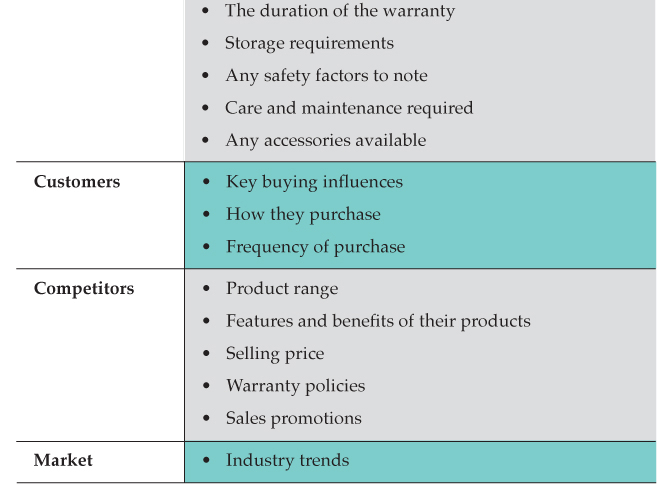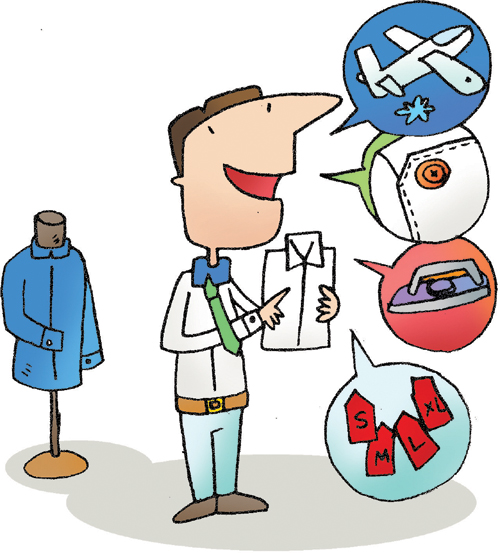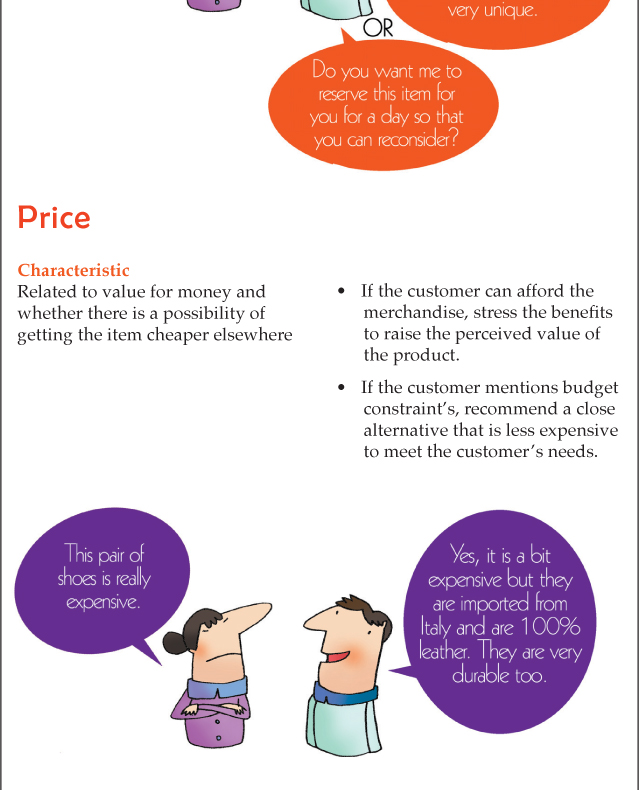Chapter 11. The Art of Retail Selling

A retailer meets many customers at the store every day. Once the customers are inside the store, personal selling becomes all important.
Selling is the process of assisting a customer make a decision to buy a product or service. It helps the customer to identify the need or want for the product or service and to understand its features and benefits. Selling requires a lot of time, energy and cost but the payoff can be tremendous. It is, therefore, beneficial for retailers to be aware of effective retail selling approaches so that they can become more confident and professional in selling their products and services to customers.
The Retail Selling Process
Whether selling apparels shoes, furniture or electronic devices, retail salespersons assist customers in finding what they are looking for and try to interest them in buying the merchandise. They describe a product’s feature, demonstrate its use or show various models and colours. All these actions that may ultimately lead to a sales transaction form the retail selling process.
The retail selling process consists of eight steps, none of which is less important than any other if the process is to be effective.
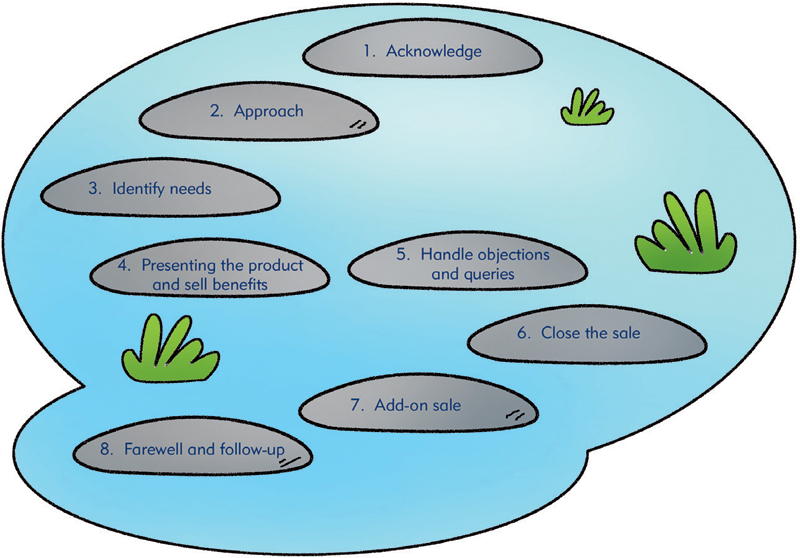
Pre-Customer Contact
In order to effectively handle all the steps in the selling process, the retail salesperson must first be equipped with knowledge, particularly specific knowledge. Such knowledge will help them handle customer inquiries, supply information and overcome objections more confidently.
Here is a list of basic information that the retail salesperson should be equipped with.
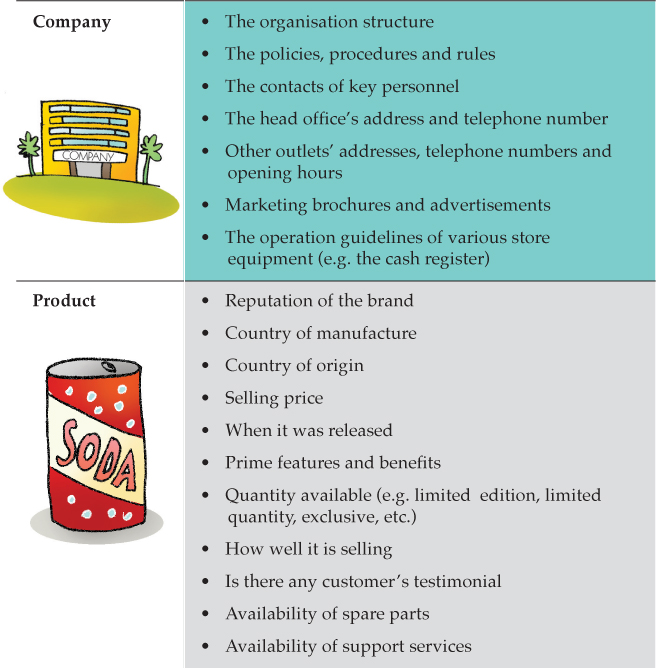
To most retail salespersons, the greatest challenge of the job is to know enough about the products they sell. This is because things are constantly changing, for example, new models, new releases, etc.
How do the retail salespersons obtain the product information? They can read the product manual (if there is), read about the new releases in magazines, try it out themselves, ask suppliers or ask their colleagues.
The pursuit of knowledge must be a continual process. One can never rest on what was learnt at the last training session. They must stay knowledgeable by keeping abreast with trends, innovations and general market conditions.
The successful application of knowledge, effective selling skills and techniques, and having the proper attitude would help the salesperson to make more sales.
 Acknowledge
Acknowledge
A first impression is hard to change. Thus it is important to create a positive first impression with customers. A simple way to acknowledge the customers’ presence and make them feel welcome is by greeting them the moment they enter the store.
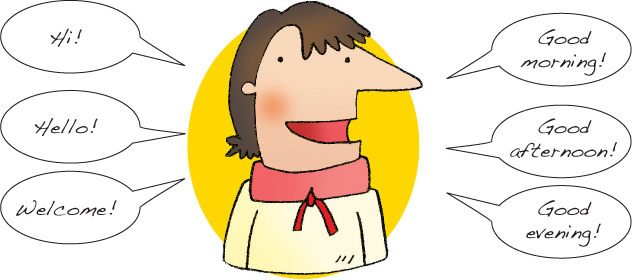
If the customer is a regular customer of the store, greet the customer by his name, for example, “Welcome, Mr Lee.”
Be mindful of the words, tone of voice, facial expression and gesture. All these will communicate to the customer the sincerity and willingness to serve. For example, a lively tone of voice and a sincere smile demonstrate a confident and friendly greeting.
If the salesperson is busy with another customer, he should tell the waiting customer, “I’ll be with you in a moment.” Such actions will reduce the number of customers who will leave without being served.
When the salesperson is free to help the waiting customer, the initial greeting should be, “Thank you for waiting.”
A courteous, creative initial contact with the customer can go a long way to promote sales.
However, a greeting need not always be verbal. An acceptable greeting when you are busy serving another customer can be a nod, a smile or just eye contact. This action allows customers to know that you are aware of their presence.
Many customers find it threatening if you march up to them immediately after greeting them. Unless the customer walks straight to you to ask for help, allow the customer a few seconds to ‘settle in’ before you approach the customer.
However, there are occasions when the salesperson acknowledges and approaches the customer at the same time. This practice is also acceptable.
 Approach
Approach
Most initial approaches begin in this manner:
Retail salesperson: “Can I help you?”
Many customers are used to hearing this statement and thus the response is usually given without thinking:
Customer: “No, thank you. I’m just browsing.”
The most effective way to close a sale is to open it on a positive note.
So, instead of immediately approaching the customer, observe the customer to pick up some clues before starting conversation. By observing, you will probably use one of the following approaches to begin a conversation:
• Social approach
• Product approach
• Service approach
Social Approach
The social approach is recommended when the customer browses and does not show any particular interest in any merchandise. The social approach can be as follows:
• “Good morning, how are you today?”
• “What brings you in on such a gorgeous day?”
The purpose of the above approach is to establish an atmosphere of friendliness to begin a positive connection. Thus you should always use a smile and a pleasant tone of voice.

Open a sale on a positive note
Product Approach
The product approach is recommended when the customer touches a product, tries it out or begins reading the product information on the packaging. The product approach can be as follows:
Customer: “Um, nice lotion.”
Retail salesperson: “That’s our most popular line. Try it!”
If a customer sits on a sofa to test it out, your opening statement could be:
Retail salesperson: “This is our new arrival. Do you like it?”
Remember, your comments should be a general comment about the product. You can comment on the colour, the uniqueness, the design, the price (if there is a promotion), the brand name, etc.
By using the product approach, you are trying to create an opening conversation with your customer to understand what he wants. Once the customer senses that you are sincerely interested in his needs, the conversation will continue.
Service Approach
The service approach is recommended when the customer knows exactly what he wants, is in a hurry or has a product in his hands. The service approach can be as follows:
• “How can I help you today?”
• “Is there something you are looking for?”
• “Can I help you to bring this item to the cashier counter?”
Combined Approach
Sometimes, the acknowledgement step can be combined with any of the approaches above, for example:
• “Good morning, Mr Chan! How are you today?” (greet and social)
• “Good morning, Ms Ong! We have lots of new arrivals today.” (greet and product)
• “Good morning, Mrs Wong! How may I help you today?” (greet and service)
If, despite using the above approaches, the customers say that they are just browsing, do reply by saying:
• “Just let me know if you need any assistance.”
Sometimes, you are not sure whether the customer has been approached by your colleagues because you just came out from the store room. In this case, you need only to acknowledge the customer with a friendly greeting first. If possible, check with your colleagues if the customer has been approached.
 Identify Needs
Identify Needs
There are many reasons why a customer buys a product. Whatever the underlying reason is, all customers would want to receive more value from the product they have purchased than what they have paid.
Selling the way the customer wants to buy is more important than selling the way the retailer likes to sell.
To assist the customer in receiving more value from the product they purchase, the retail salesperson should use consultative selling, that is, focus on the customers’ needs and then provide product or products that meet those needs. In other words, instead of product features and benefits, the salesperson should emphasise the customers and their goals.
Talk to Your Customers
The primary aim of speaking to customers is to find out as much about their needs as possible. These include:
• Purpose of buying
• Price range
• Personal preference
• Product features or specifications

“How do I identify customers’ needs?”
Knowing the needs and wants of customers will help build a picture of what you can do for them. This will, in turn, open new opportunities for sales. For example:
• By knowing the purpose of buying a product (i.e. what the product is used for), the sales associate is able to make an appropriate recommendation or an alternative if the product wanted by the customer is not available.
• By knowing the price or price range that the customer is willing to pay for a product, the sales associate is able to suggest something within the customer’s budget.
• By knowing the customer’s preference, the sales associate is able to know the customer’s likes and dislikes.
It is important to note that what is popular with most people may not be what the customer like.
• By knowing the product features or specifications that the customer wants, the sales person is able to help the customer find a suitable product.
Listen, Observe and Ask
When the retail salesperson communicates with a customer to identify needs, bear in mind the following:
• Learn to listen
Being attentive to the customer’s needs makes the customer feel important.
The best salespeople are those who listen more than they talk.
The retail sales associate should ask reflective questions (where necessary) to show that he is listening and to clarify what is being heard. For example, “Since you mentioned that you will be travelling a lot, would you then prefer to buy a more durable suitcase?”
By listening, the salesperson is able to pick up information that can help to make a sale. By listening attentively, the salesperson need not ask too many questions. Asking too many questions can make the customer feel that the salesperson does not want to show him too many products.
Body language (or non-verbal communication) is an important part of communication which, according to at least one study, constitutes more than 50 percent of what we are communicating. Body language refers to the use of body movements as a form of communication. For example, if the customer keeps looking at the watch while talking to the salesperson, it can imply that the customer is in a hurry. But the salesperson must be careful not to draw a wrong conclusion. It will be good to ask the customer, “Are you in a hurry?”
The retail salesperson should also use appropriate body language when listening to his/her customers. These include nodding, maintaining eye contact or smiling.
• Ask the right questions
Questions that have a “Yes” or “No” answer are called closed questions. For example, asking the customer if they would like a product with more benefits at a special price is unlikely to get a negative response. A positive response will usually generate a customer’s interest in the product.
Always start with questions that can only be answered “Yes” or “No”.
Closed questions also help to clarify information. But, do not use too many closed questions as it can make the customer feel like he is going through an interrogation.
• Ask open-ended questions
The best salesperson is one who moves on to asking open-ended questions after asking the right questions. This will reveal more about the customer’s needs. Open-ended questions usually begin with What, When, Why, Who, Where and How.
– “What colour do you have in mind?”
– “When do you intend to wear the dress?”
– “Where is the party being held?”
– “How do you like to dress for that party?”
But bear in mind not to ask too many questions.
Keep the questions simple. Also, a good mix of open and closed questions can be helpful in gathering information about the customer’s needs and wants, and match them to the appropriate product that the store sells.
• Ask the customer if he has other queries
Seek to clarify the customer’s doubts. If the customer’s further queries are questions such as “Do you have a new piece in stock?” or “When can you deliver?”, these are cues for you to close the sale.
In addition to the above, the retail salesperson must also be aware of some factors that influence the buying decisions of customers. One such important factor is cultural influence.
Culture affects a person’s actions and decisions.
It includes customs, values and beliefs. For example, if you are serving an Indian customer who is looking for a leather bag, do not show this customer a bag that is made of cow skin. This is because many Indians are Hindus, and Hindus consider the cow as a sacred animal. Thus such a bag is a taboo item for the Indian customer.
 Present the Products and Sell Benefits
Present the Products and Sell Benefits
After identifying the customer’s needs, the retail salesperson is ready to present and sell the merchandise to the customer. The optimal use of product knowledge is very important in presenting the merchandise to the customer.
Present the Product
Involve the customer
The best way to present a product is to involve the customer. Product knowledge can be used to get customer involvement. For example, show the customer several features of a product and then have the customer try it. Always allow the customer to touch and feel the product.
Limit the choices
Based on the needs of the customers select a few products (usually not more than three) for the customer to consider or try.
Limited choices can often help to promote sales.
Giving the customer too many choices can cause indecisiveness and thus the purchase will most likely be postponed.
Sell enthusiastically
In presenting the merchandise to the customer, the salesperson must be enthusiastic about the product.
For example:
• Bring the product out of the cabinet and let the customer have a closer look.
• Demonstrate the product in such a way that it captures attention and is easy to use.
Provide selective information
Do not bore the customer with too many facts, especially those that the customer already knows. If the needs have been identified through earlier conversations with the customer, the salesperson just needs to
emphasise the facts that meet those needs and highlight other interesting features and benefits that may enhance the sale of the product.
If the customer is keen to know more, then the salesperson can proceed to explain further.
Sell Benefits
So, what makes the customer buy? Benefits!
Every product has features. A feature is a characteristic of a product. It is tangible. It also includes the brand, price or material. These information is usually shown on the product packaging.
A feature offers benefits, that is, a solution to a specific need. Benefits mean what the product can do for customers. Rather than simply describing its features,
Highlighting the product’s benefits is more likely to result in a sale.
Successful selling requires the salesperson to show customers how the product meets their needs.
For example, a customer may not be as concerned about how much horsepower (a feature) a lawnmower has as much as he is interested in how fast (a benefit) the lawnmower can cut grass.
Remember...
features tell but benefits sell!
In selling benefits, the retail salesperson must always put himself in the customer’s shoes. Always look at the product as a solution and understand what issues it can address. This will indirectly help the salesperson to illustrate how the product’s benefits can meet the customer’s needs or solve the customer’s problem.
There are, however, two types of benefits: rational benefits and emotional benefits. Rational benefits offer solutions (a need) to the customer’s problem. Emotional benefits appeal to the good feelings (a want) of the customer. For example, a particular brand of watch has good quality and is trendy. In this case, brand is a feature, good quality is a rational benefit and trendy is an emotional benefit.
How Can Selling Be Enhanced?
Selling can be enhanced if the retail salesperson can
quantify the benefits.
For example, the number of testimonials from customers who have used the product and are very satisfied with the product can be used to quantify the benefits.
Another example is to equate the benefit’s in terms of dollars and cents to the cost of the product. If the retail salesperson can prove that a product has saved a customer $500 on electrical bills over one year, and it only costs $100 to buy the product, then the customer is more likely to buy the product.
In addition, it will be helpful if the salesperson can differentiate a product from its competitors. The retail salesperson should always be prepared to answer this question from the customer: “Why should I buy this product from you?” or “Why should I buy this brand?” If the salesperson has at least two or three reasons for these questions, particularly based on quantifiable benefits the product offers, then there is a high chance that the product will be sold.
It is important that the salesperson should never ‘run down’ one product to promote another.
Instead, he should point out the extra value of the alternative. The salesperson’s role is to ensure the customer is aware of the options available and the benefits of each. For example:

 Handle Objections and Queries
Handle Objections and Queries
Very often, the customer may express some concerns about the merchandise or question the need for it. These doubts and concerns are called objections or queries. Objections are reasons that customers have for not buying the merchandise. Queries are questions raised because customers do not have enough information about the merchandise. Thus objections and queries are related. If a customer’s query about the features of the merchandise is not handled properly, it would lead to an objection to buy it.
Generally, most retail salespeople are afraid of objections. Objections are a natural part of the selling process. They do not mean that the sale is lost. In fact,
the presence of objections implies opportunities to close a sale.
In most cases, to overcome an objection, the retail salesperson needs only to do more selling.
Reasons for Objections
Customers raise objections because
• They are doubtful of the information given by the retail salesperson about the merchandise.
• They do not have enough information about the merchandise to make a rational decision.
• They are doubtful about whether the merchandise will meet their needs.
• They do not find the price of the merchandise value for money.

A customer’s objections are reasons for not buying the merchandise.
Guidelines to Overcome Objections
Generally to overcome objections, the retail salesperson needs to:
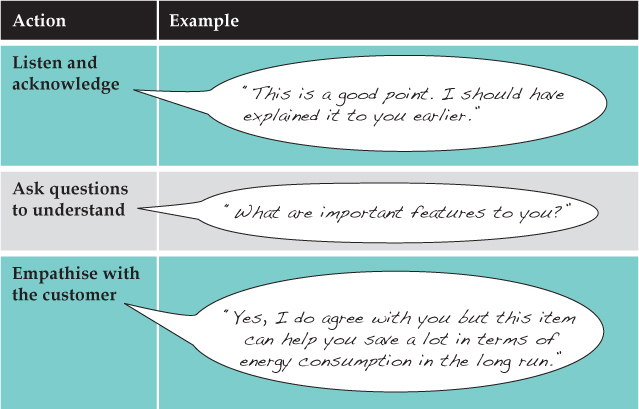
Types of Objections
Objections could be met by the salesperson in several ways.


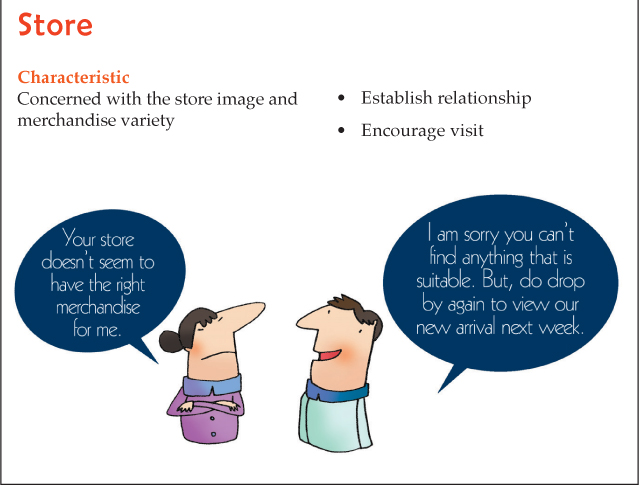
 Close the Sale
Close the Sale
Closing the sale is a very important step. Very often, sales are lost because the retail salesperson fails to close the sale promptly. The retail salesperson either closes the sale too early or misses the buying signals to close the sale.
Buying Signals
A buying signal is something the customer says (verbal) or does (non-verbal) that would indicate that he is ready to buy. Here are some common buying signals
• The customer asks questions about the benefits that the salesperson has mentioned earlier.
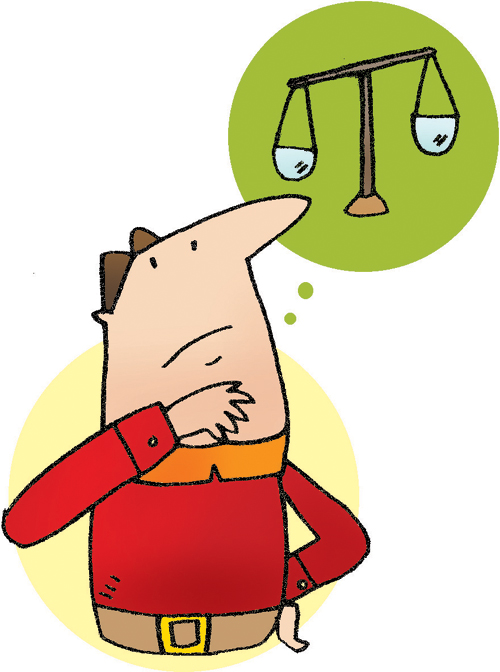
• The customer prefers one merchandise over the others after a few products have been presented to him.
• Customer seeks the opinion of his friend or partner who is shopping with him; customer calls over his partner or friend whom he is shopping with to look at the product.
• The customer asks whether he can pay by credit card.
• The customer asks whether there is any discount or free gift.
• The customer tries on a product (e.g. a watch) and seems interested to keep it on.
• The customer keeps looking at a product with serious interest.
• The customer keeps taking up the product.
Once the customer has given a buying signal, the salesperson should stop selling and try to close the sale.
Ways to Close a Sale
Here are some closing techniques.

After all objections have been met, the retail salesperson should allow the customer time to decide. If the customer says yes, proceed to process the payment. If the customer says no, accept his decision. However, let the customer know that he is always welcome to call upon you again if he or she needs further information.
It is important for the retail salesperson to note that putting pressure on customers to buy may boost sales but he may risk making the customers feel unhappy with their purchase. This could make customers less likely to come to the store again. They may even return the products when they have had time to think things over more carefully.
Thus the retail salesperson must try to establish a continuing relationship with all the customers instead of just concentrating on making sales.
 Add-On Sale
Add-On Sale
After the customer has made a purchase, the salesperson can make a suggestion for a possible additional sale, that is, selling add-ons. Also known as suggestion selling, add-on sale is an extra item that is sold with a purchase. Such an action not only adds value to the business, it also adds value to the customer.
In many cases, suggestion selling may help the customer to avoid another shopping trip to buy that needed item that they had not thought about.

Suggesting additional purchase with purchase is value-adding to both the retailer and the customer.
Good suggestion selling makes sales and builds confidence in the company’s business.
In fact, most customers like to receive valid suggestions.
There are two types of add-on sellings – related merchandise and unrelated merchandise.
Related merchandise is usually accessories for or complements to the product that the customer has purchased.
Examples of selling related merchandise:
• When the customer buys a shirt, what about a tie to go with it?
• If a torch is purchased, what about the batteries to turn it on?
• If a suit is bought, what about a new shirt that goes well with the colour?
Selling unrelated merchandise is a suggestion to the customer especially when there are specials or providing information to the customer when there are new arrivals. This can be done after the customer has made a purchase and is waiting for the payment to be processed.
Examples of selling unrelated merchandise:
• When the customer buys a bottle of shampoo (normal size), inform him that it also comes in jumbo economy size.
• When the customer buys a lipstick, inform her that there is a new batch of facial masks that just arrived.
If possible, the salesperson should get the suggested item, show it to the customer and explain the reason for such a suggestion. The salesperson should also take the initiative to offer additional service where possible. For example, if a person brings in a watch to be repaired, ask the customer whether he would like the watch to be cleaned while it is taken apart. This type of initiative shows how much the retailer cares about the customer and usually results in more repeat business.
However, the following are not good examples of suggestion selling because there are no products being recommended:
• “Is there anything else you need?”
• “Do you need me to get you something else?”
Selling Up
Add-on sale can sometimes involve selling up, that is, selling a product which is of higher value. The retail salesperson should consider taking this selling approach if:
• There are extra benefits with the higher-value product.
• The quality of the higher-value product is more value for money.
• The performance of the higher-value product is better.
However, the salesperson should not force or trick the customer into buying the more expensive product. The focus should be on the customer’s needs.
 Farewell and Follow-Up
Farewell and Follow-Up
Even after the salesperson has successfully closed a sale, there are still things to be done. Completing the transaction includes handing a receipt to the customer, packaging the merchandise appropriately and asking whether the customer needs further assistance.
Farewell
The closing statements, “Thank you for shopping at ...” and “Have a nice day”, are commonly used after the customer has paid for the merchandise and is about to leave the store. This closing statement is a form of sales follow-up. If done with enthusiasm, it allows the customer to leave on a positive note, thereby increasing the chances of repeat business by the customer.
In some situations, the retail salesperson should offer the customer a business card (if there is one) or the store information card. This happens if the customer is still considering the product and wants a day or two to make a decision. The card will serve as a reminder that if the customer decides to buy, the salesperson will be ready to serve.
Follow-Up
Follow-up is a part of every sale. Follow-up may also involve checking on any promises that were made to the customer after the sale.
For example, if a delivery is supposed to take place on Friday, the salesperson should check to make sure that the promise is met. If the promise is not met, notify the customer of the problem promptly. Good sales follow-up will avoid any inconvenience caused to the customer, for example, having the customer wait for the delivery or call to ask about the delivery on that day.

In another instance, the customer will certainly be pleased if the carpet cleaning service company telephones the customer the next day after cleaning his carpets to check that everything is satisfactory.
A business with a reputation for sales follow-up is going to obtain additional business because it shows that the company does care for the customer even after the sale.
Sincere sales follow-up builds goodwill and encourages repeat business.
Get Ready to Sell by Building Confidence
Having confidence in yourself and your product has a direct influence on your ability to sell successfully. A self-confident salesperson is one who speaks clearly and answers questions assuredly.
If you do not have confidence in yourself and do not believe in the product that you sell, your customers could sense it and might not buy from you. This is because your level of self-confidence can show in your behaviour, your body language, how you speak and what you say. Self-confident salespeople inspire confidence in their customers.
Self-confidence comes from a strong belief in yourself and that is something you can learn over time. To help build that confidence, you must have a good understanding of your product, your customers, your competition and the most effective selling techniques.

